 HE accompanying picture shows that the arched entrance can be as low as three inches, and still be high enough not to hinder the passage of a soldier wearing a very tall hat.
HE accompanying picture shows that the arched entrance can be as low as three inches, and still be high enough not to hinder the passage of a soldier wearing a very tall hat.
--more--

Go to top of page
| For reference books and articles relating to these pages, see our bibliography | ||
| Are you getting tired of looking at a madman's toys? Take a trip on the Grand Imperial Railway, or visit The Heraldry Guy! | Searching for a particular topic in these pages? Try our subject index (updated frequently) | |
| Go to the Next Plate | Go to the Previous Plate | Go to the Numerical Plate Directory |
Plate 34: The photographer gauges the height of the arch under the battlements
(This plate added FEB 2004)
 HE accompanying picture shows that the arched entrance can be as low as three inches, and still be high enough not to hinder the passage of a soldier wearing a very tall hat.
HE accompanying picture shows that the arched entrance can be as low as three inches, and still be high enough not to hinder the passage of a soldier wearing a very tall hat.
|
|
|
Strictly speaking, it is the vertical sides of the archway that must not be less than three inches high. The semi-circular part of the arch above the vertical sides will, of course, be taller than three inches at the middle.
--more-- |

|
|
Architecturally speaking, the vertical sides of the archway are called the vertical supports, and the horizontal line where the vertical supports meet the semi-circular arch is called the springing line. So, to sum it all up, the vertical supports of the entrance archway to our little castle must not be less than three inches high.
Go to top of page |
|